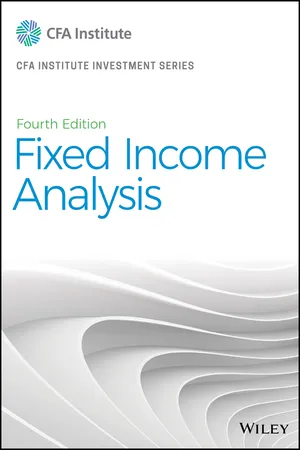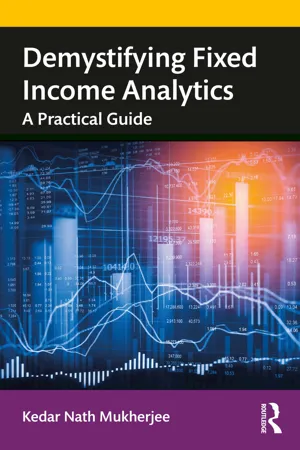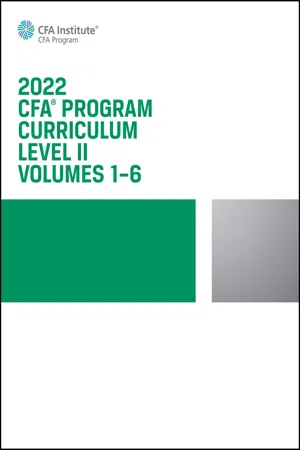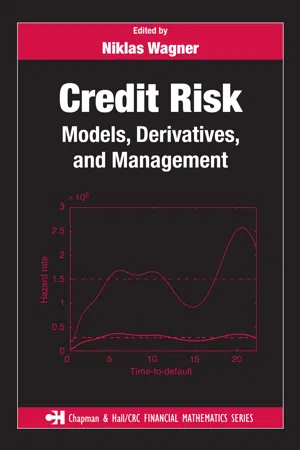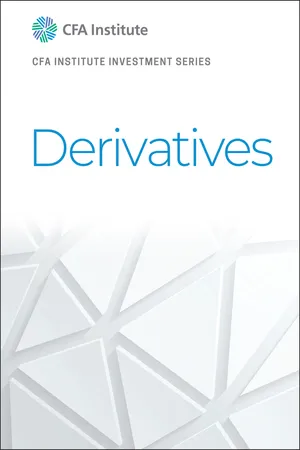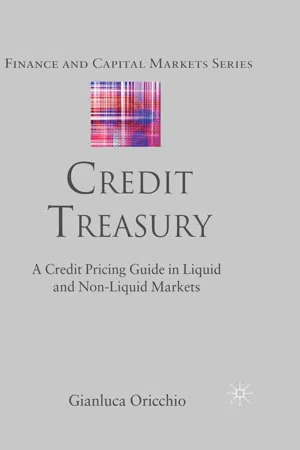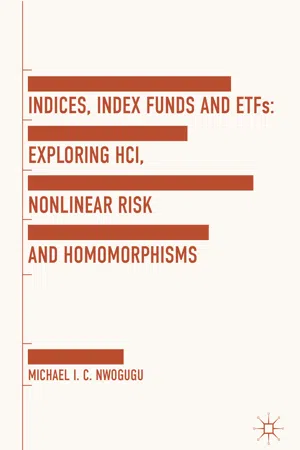Economics
Credit Default Swaps
Credit Default Swaps (CDS) are financial derivatives that allow investors to hedge against the risk of default on a loan or bond. In a CDS, the buyer makes periodic payments to the seller in exchange for protection against potential credit events. If a credit event occurs, the seller compensates the buyer for the loss incurred. CDS can also be used for speculative purposes.
Written by Perlego with AI-assistance
Related key terms
1 of 5
12 Key excerpts on "Credit Default Swaps"
- No longer available |Learn more
- Barbara S. Petitt(Author)
- 2019(Publication Date)
- Wiley(Publisher)
CHAPTER 11 Credit Default Swaps Brian RoseDon M. Chance, PhD, CFALearning Outcomes
After completing this chapter, you will be able to do the following:- describe Credit Default Swaps (CDS), single-name and index CDS, and the parameters that define a given CDS product;
- describe credit events and settlement protocols with respect to CDS;
- explain the principles underlying, and factors that influence, the market’s pricing of CDS;
- describe the use of CDS to manage credit exposures and to express views regarding changes in shape and/or level of the credit curve;
- describe the use of CDS to take advantage of valuation disparities among separate markets, such as bonds, loans, equities, and equity-linked instruments.
1. Introduction
Acredit derivativeis a derivative instrument in which the underlying is a measure of a borrower’s credit quality. Four types of credit derivatives are (1) total return swaps, (2) credit spread options, (3) credit-linked notes, and (4) Credit Default Swaps, or CDS.1 The first three are not frequently encountered. CDS have clearly emerged as the primary type of credit derivative and, as such, are the topic of this chapter. In a CDS, one party makes payments to the other and receives in return the promise of compensation if a third party defaults.In any derivative, the payoff is based on (derived from) the performance of an underlying instrument, rate, or asset that we call the underlying.2 For a CDS, the underlying is the credit quality of a borrower. At its most fundamental level, a CDS provides protection against default, but it also protects against changes in the market’s perception of a borrower’s credit quality well in advance of default. The value of a CDS will rise and fall as opinions change about the likelihood of default. The actual event of default might never occur.Derivatives are characterized as contingent claims - eBook - PDF
- Hung-Gay Fung, Yiuman Tse, Hung-Gay Fung, Yiuman Tse(Authors)
- 2013(Publication Date)
- Emerald Group Publishing Limited(Publisher)
5 Sovereign Credit Default Swap Gaiyan Zhang College of Business Administration, University of Missouri-St. Louis, One University Blvd, St. Louis, MO 63121, USA E-mail address: [email protected] Abstract This chapter provides a comprehensive overview of the young, but rapidly growing sovereign credit default swap (CDS) market, describes the function, trading, history, market participants, key statistical and stylized facts about CDS prices, determinants, price discovery, and risk issues. Keywords: Sovereign credit default swap, price discovery, risk 1. Sovereign credit default swap The credit default swap (CDS) is the simplest type of credit derivatives that offer protection against the credit or default risk of bonds or other types of loan arrangements. This new class of assets is designed to transfer and manage credit risk on a variety of corporate and sovereign names with a wide range of maturities (6 month to 30 years with 5-year maturities the most liquid compared to other maturities (1, 3, 7, 10, 30 year) in the market.). It also provides a new asset class for investors. The CDS market is primarily comprised of two sectors: the corporate sector and the sovereign sector, which accounts for about 9% of the market and mostly composed of credit derivatives on emerging sovereign bonds ( BIS, 2012) . The corporate CDS allows the transfer and management of credit risks of underlying corporate entities. The sovereign CDS offers protection against the default of a referenced sovereign government. After the recent financial crisis, it also serves as an increasingly important gauge of the underlying riskiness of sovereign borrowers for policy makers, regulators, and investors. The CDS buyer makes periodic payments, generally referred to as the CDS spread (premium), to the protection seller over the life of the swap contract in exchange for compensation of a notional amount of debt if Frontiers of Economics and Globalization r 2013 by Emerald Group Publishing Limited. - eBook - ePub
Demystifying Fixed Income Analytics
A Practical Guide
- Kedar Nath Mukherjee(Author)
- 2020(Publication Date)
- Routledge India(Publisher)
12 Credit Default SwapsKey learning outcomes
At the end of this chapter, the readers are expected to be familiar with:- Meaning and history of Credit Default Swaps, especially in light of 2008 US subprime crisis.
- Different types of Credit Default Swaps, with special reference to emerging markets.
- Important features of Credit Default Swaps, in line with RBI guidelines on CDS.
- Current scope of CDS in India and its future challenges.
Meaning and definition of credit derivativesCredit Derivatives are financial instruments designed to transfer the credit risk from one counterparty to another. In other words, a credit derivative is a Privately Negotiated contract the value of which is derived from the credit risk of a bond, a bank loan, or any other instrument with an exposure to credit risk. Credit derivatives can have the form of forwards, swaps, and options, which may be embedded in financial assets like bonds or loans or other investments with a credit risk exposure. Therefore, credit derivatives, on the one hand, allow investors or creditors to eliminate or reduce credit risk involved in their investment, and allow the counterparty to make some profit and leverage their position by assuming the credit risk in their own books of accounts. On the other hand, credit derivatives can be defined as arrangements that allow one counterparty (Protection Buyer) to transfer, in exchange of a certain price called Premium, the defined credit risk (full or in part), computed with reference to a notional value, of a reference asset(s), with or without its actual ownership, to another counterparty or counterparties (Protection Seller).There are different basic and complex or synthetic derivatives products or instruments used to mitigate the credit risk that a person or entity carries in their books of accounts. Broadly, credit derivative instruments are classified into four categories: Credit Default Swaps (CDS), total rate of return swaps (TRORS), credit spread products, and different synthetic structures. Again, credit spread products include credit spread forward/futures, credit spread options, credit spread swaps, etc. Similarly, credit link notes (CLN), collarized debt obligations (CDOs), etc. are some of the examples of synthetic credit derivatives instruments. All the above products may be simple in nature, or they may have a complex structure based on the type of the products. Apart from having a common purpose of hedging against credit risk exposure, different credit derivative products have some identical features that can differentiate one product from the other. - eBook - ePub
- (Author)
- 2021(Publication Date)
- Wiley(Publisher)
In addition, the CDS market has increased transparency and insight into the actual cost of credit risk. The higher relative liquidity and relative sophistication of CDS investors allow for more accurate price discovery and facilitate trading during liquidity events when the cash market for bonds becomes illiquid. While many of the applications listed above are beyond the scope of this reading, a basic understanding of this important fixed-income tool is necessary for all investment professionals.Let’s now define a credit default swap :A credit default swap is a derivative contract between two parties, a credit protection buyer and credit protection seller, in which the buyer makes a series of cash payments to the seller and receives a promise of compensation for credit losses resulting from a credit event in an underlying.In a CDS contract there are two counterparties, the credit protection buyer and the credit protection seller . The buyer agrees to make a series of periodic payments to the seller over the life of the contract (which are determined and fixed at contract initiation) and receives in return a promise that if default occurs, the protection seller will compensate the protection buyer. If default occurs, the periodic payments made by the protection buyer to the protection seller terminate. Exhibit 1 shows the structure of payment flows.Exhibit 1. Payment Structure of a CDSCredit Default Swaps are somewhat similar to put options. Put options effectively enable the option holder to sell (put) the underlying security to the option seller if the underlying performs poorly relative to the exercise price. Similarly, in the event of a credit event on the underlying security, the buyer of credit protection receives a payment from the credit protection seller equal to the par or notional value of the security less the expected recovery value. If the credit quality of the underlying deteriorates but there is no outright credit event, the credit protection buyer is compensated only if the contract is unwound. How that compensation occurs and how much protection it provides are some points we will discuss. - eBook - PDF
Credit Risk Modeling
Theory and Applications
- David Lando(Author)
- 2009(Publication Date)
- Princeton University Press(Publisher)
We focus therefore on some basic calculations which are helpful for the simulations. Once simulations are called for, the worry then becomes what kind of correlation structure to impose, and this is the topic of the next chapter. 8.1 Some Basic Terminology The market for credit risk transfer is rich with institutional details and we will not attempt to go into a lot of detail here. Rather, this section serves as an introduction to the most important structures and hints at their definitions and uses. 198 8. Credit Default Swaps, CDOs, and Related Products 8.1.1 The Single-Name Credit Default Swap (CDS) The most important instrument in the credit derivative market is the credit default swap, which essentially provides insurance against the default of an issuer (the reference credit) or on a specific underlying bond (the reference security). In its most basic form the buyer of the protection pays an annual (or semiannual) premium until either the maturity of the contract or default on the reference entity, whichever comes first. If a default occurs, the seller of the protection compensates the buyer for the loss on the reference security by either paying the face value of the bond in exchange for the defaulted bond (physical settlement) or by paying an amount of cash which compensates the buyer of the protection for the difference between the post-default market value of the bond and the par value (cash settlement). The post-default market value is determined based on polling of dealers. In the case of a physical settlement, the protection seller often has a “wildcard” option to deliver one of several bonds from the defaulted issuer. Some cash-settled contracts have a settlement amount which is fixed in advance. This less-common contract is often referred to as a “digital” or “binary” default swap. Typically, the underlying credit of a default swap is a rated firm with publicly traded debt or a sovereign entity. - eBook - PDF
Credit Risk
Models, Derivatives, and Management
- Niklas Wagner(Author)
- 2008(Publication Date)
- Chapman and Hall/CRC(Publisher)
Currently, the most important credit derivative is the credit default swap (CDS). A CDS is essentially an insurance contract providing protection against losses arising from a * The credit derivatives market is of course still small compared to the largest OTC (over-the-counter) derivatives markets in the world. Interest rate related OTC derivatives contracts constitute around $177 trillion in notional amounts and foreign exchange related OTC derivatives make up about $32 trillion (BIS 2004). y The most well-known approach of calculating these probabilities using stock market information is the Merton (1974) model. 70 & Credit Risk: Models, Derivatives, and Management credit event, and with CDSs, investors can go both long and short in a particular credit without having to fi nd the underlying asset. This makes them more accessible and easier to trade than their underlying reference entities. Recently, tradable CDS indexes have also been introduced that allow investors quick and easy ways to buy and sell market-wide or sectoral credit risk. In June 21, 2004, the two main CDS indexes, iBoxx and Trac-x, were merged into the Dow Jones iTraxx index that since has set a new standard when it comes to liquidity, transparency, and diversi fi cation. Large exposures (negative or positive) to a diversi fi ed pool of credit risks are now much easier to gain and the liquidity of the iTraxx market has attracted new participants such as hedge funds and capital structure arbitrageurs. This chapter discusses the link between CDS spreads and equity prices as well as volatilities in the iTraxx market. The link between stock prices and CDS spreads has been studied before but as far as we know this is one of the fi rst papers looking at the link between stock return volatilities and CDS spreads. - eBook - PDF
- (Author)
- 2021(Publication Date)
- Wiley(Publisher)
The CDS seller clearly gains, having been paid to bear the risk of default that is becoming increasingly unlikely, and the CDS buyer loses. The buyer loses on the CDS because it paid premiums to receive protection in the event of a default, which did not occur. Although the CDS position itself is a loss, the buyer’s overall position is not necessarily a loss. If the buyer is a creditor of the reference entity, the premium “loss” is no different than a homeowner’s insur-ance premium payment on his house; he wouldn’t consider that payment a loss simply because his house did not burn down. 5. APPLICATIONS OF CDS Credit Default Swaps, as demonstrated, facilitate the transfer of credit risk. As simple as that concept seems, there are many different circumstances under which CDS are used. In this section, we consider some applications of this instrument. Any derivative instrument has two general uses. One is to exploit an expected movement in the underlying. The derivative typically requires less capital and is usually an easier instru-ment in which to create a short economic exposure as compared with the underlying. The derivatives market can also be more efficient, meaning that it can react to information more rapidly and have more liquidity than the market for the underlying. Thus, information or an expectation of movement in the underlying can often be exploited much more efficiently with the derivative than with the underlying directly. The other trading opportunity facilitated by derivatives is in valuation differences between the derivative and the underlying. If the derivative is mispriced relative to the underlying, one can take the appropriate position in the derivative and an offsetting posi-tion in the underlying. - eBook - ePub
- Frank J. Fabozzi(Author)
- 2012(Publication Date)
- Wiley(Publisher)
Credit Default Swap Valuation REN-RAW CHEN, PhD Professor of Finance, Graduate School of Business, Fordham University FRANK J. FABOZZI, PhD, CFA, CPA Professor of Finance, EDHEC Business School DOMINIC O’KANE, PhD Affiliated Professor of Finance, EDHEC Business School, Nice, France Abstract: Credit Default Swaps are the most popular of all the credit derivative contracts traded. Their purpose is to provide financial protection against losses incurred following a credit event of a corporate or sovereign reference entity. Replication arguments attempting to link Credit Default Swaps to the price of the underlying credits are generally used by the market as a first estimate for determining the price at which a credit default swap should trade. The replication argument, however, is dependent on the existence of same maturity and same seniority floating rate bonds. Even if such securities do exist, contractual differences between CDS and bonds can weaken the replication relationship. Over the past decade, the increased liquidity of the CDS market has meant that in some cases, it, and not the bond market, is the place where credit price discovery occurs. Despite this it still necessary to have a CDS valuation model for the valuation and risk-management of existing positions. Credit Default Swaps (CDSs), or simply default swaps, provide an efficient credit-risk transferring financial instrument. Their over-the-counter nature also makes them infinitely customizable, thereby overcoming many of the limitations of the traditional credit market instruments such as lack of availability of instruments with the required maturity or seniority - No longer available |Learn more
- (Author)
- 2014(Publication Date)
- White Word Publications(Publisher)
A taxpayer must include income from Credit Default Swaps in ordinary income if the swaps are connected with trade or business in the United States. The accounting treatment of Credit Default Swaps used for hedging may not parallel the economic effects and instead, increase volatility. For example, GAAP generally require that Credit Default Swaps be reported on a mark to market basis. In contrast, assets that are held for investment, such as a commercial loan or bonds, are reported at cost, unless a probable and significant loss is expected. Thus, hedging a commercial loan using a CDS can induce considerable volatility into the income statement and balance sheet as the CDS changes value over its life due to market conditions and due to the tendency for shorter dated CDS to sell at lower prices than longer dated CDS. One can try to account for the CDS as a hedge under FASB 133 but in practice that can prove very difficult unless the risky asset owned by the bank or corporation is exactly the same as the Reference Obligation used for the particular CDS that was bought. LCDS A new type of default swap is the loan only credit default swap (LCDS). This is conceptually very similar to a standard CDS, but unlike vanilla CDS, the underlying protection is sold on syndicated secured loans of the Reference Entity rather than the broader category of Bond or Loan. Also, as of May 22, 2007, for the most widely traded LCDS form, which governs North American single name and index trades, the default settlement method for LCDS shifted to auction settlement rather than physical settlement. The auction method is essentially the same that has been used in the various ISDA cash settlement auction protocols, but does not require parties to take any additional steps following a credit event (i.e., adherence to a protocol) to elect cash ____________________ WORLD TECHNOLOGIES ____________________ settlement. On October 23, 2007, the first ever LCDS auction was held for Movie Gallery. - eBook - PDF
Credit Treasury
A Credit Pricing Guide in Liquid and Non-Liquid Markets
- G. Oricchio(Author)
- 2011(Publication Date)
- Palgrave Macmillan(Publisher)
CDS Valuation and Trading Strategies* 4.1 COMPARING BONDS TO Credit Default Swaps Credit Default Swaps and bonds of the same credit will usually trade similarly, as both reflect the market's view of default risk. As discussed, a CDS is a measure of credit risk of an entity. Credit Default Swaps are not measured as a spread over a benchmark, rather, the spread is the annual coupon the buyer of protection (short risk) will pay and the seller of protection will receive. Quite simply, the higher the perceived credit risk, the higher the CDS spread. In order to compare Credit Default Swaps with bonds, one needs to isolate the spread of the bond that compensates the holder for assuming the credit risk of the issuer. 4.1.1 Decomposing risk in a bond To make the comparison between Credit Default Swaps and bonds, we assume that the yield on a typical fixed-rate corporate bond is intended to compensate the holder for the following: Risk-Free rate: the bond holder could earn this yield in a default/risk-free investment (for example, the US Treasury rate). Funding risk: This is the swap spread. While this is a type of credit risk, it is not specific to the issuer. The swap yield (swap spread plus the risk-free rate) is the hurdle rate for many investors' investment opportunities. Credit risk: the risk that the investor might suffer a loss if the issuer defaults. * Copyright © 2010 JPMorgan Chase & Co. All rights reserved. CDS VALUATION AND TRADING STRATEGIES Bond/Loan Asset swap T + 120bp Libor +80bp Credit default swap 80bp Figure 4.1 Spreads of Credit Default Swaps can be compared to bond yields Fixed rate Ubor + Spread figure 4.2 Fixed to floating asset swap, or a "vanilla" swap For example, assume that a bond is paying a yield of Treasury rates plus 120bp (Figure 4.1). To remove interest-rate risk from owning this bond, an investor can swap the fixed payments received from the bond for floating rate payments through an asset swap. - eBook - ePub
Indices, Index Funds And ETFs
Exploring HCI, Nonlinear Risk and Homomorphisms
- Michael I. C. Nwogugu(Author)
- 2019(Publication Date)
- Palgrave Macmillan(Publisher)
While (US) Congress rejected a proposal by Senator Dorgan (D-ND) to ban naked CDSs, a proposal heavily criticized in this country, last year the European Union adopted such a ban on CDS contracts on sovereign debt. This regulation was prompted by studies indicating that short selling and CDSs enabled speculators to distort the creditworthiness of some nations. A European economics professor summarized the concern as follows: ‘The rise in sovereign and banking CDS premia changes the market’s expectations about the country’s default probability. Market participants sell bonds and banking stocks in the belief that default risk is greater. The market shifts to a pessimistic equilibrium and, in fact, sovereign default becomes more likely. Accounting for shifts in market sentiment explains the sudden eruption of the crisis in countries like Portugal or Spain, where the fundamentals have deteriorated only progressively.’ Professor Delatte was critical of the regulation, which excluded banking CDSs and exempted market makers, because it did not go far enough. She noted that large dealers in CDSs, such as J.P. Morgan, dominate the market. Similarly, Richard Portes has argued for a broad ban on naked CDSs.See the comments in Noked (Dec. 2011 ), Bruneau et al. (July 2012 ), Delatte (July 2013 ), Portes (April 2012 ), Murdock (2013 ), and Korivi and Ahmad (2012 ).- (ii)
Technically, CDSs are insurance contracts but are not used or regulated as such in many countries and that can constitute fraud on the market and market manipulation. During 2008, Attorney General Cuomo of New York State formally proposed that CDS were insurance contracts under New York Law, which is used in many international transactions. On September 22, 2008, the New York State Department of Insurance announced that it would start regulating some types of CDS as insurance contracts; but soon thereafter, it decided to indefinitely postpone the proposal—possibly because of lobbying and political pressure. While there have been many arguments for and against regulating CDSs as insurance contracts,10 the realities are that (1) there can be new and federal/national-level insurance-type regulations for CDSs (which eliminates the problems of using existing state-law insurance frameworks that may be deemed old); (2) regulating CDSs as insurance contracts forces the users and market participants to internalize the risks involved; (3) regulating CDS as insurance contracts can drastically improve capital requirements, disclosure and risk ratings, all of which can reduce systemic risk and financial instability. See the comments in Ng (Dec. 2010 ), Kimball-Stanley (2008 ), Zolnor (2009 ), Stephens and Thompson (2014 ) and Venokur et al. (Dec. 2008 - eBook - PDF
Fixed Income Securities
Tools for Today's Markets
- Bruce Tuckman, Angel Serrat(Authors)
- 2022(Publication Date)
- Wiley(Publisher)
CHAPTER 14 Corporate Debt and Credit Default Swaps C orporations borrow money to fund their operations, transactions (e.g., mergers and acquisitions), and changes to capital structure (e.g., refinance existing debt, stock repurchases). The loans and bonds used to raise these funds are subject to credit risk, because corporations may not make good on their promises to pay interest and repay principal. Lenders, in turn, require compensation for bearing credit risk in the form of higher returns. The cash flows of Credit Default Swaps (CDS) also depend on the payment or non- payment of debt obligations but are not themselves obligations of corporate issuers. In other words, through CDS contracts, market participants trade corporate credit risks with each other. While this chapter focuses mostly on corporate debt, much of the discussion applies to sovereign and municipal debt as well, because the debt obligations of many governments have at times been perceived as subject to nontrivial probabilities of default. Many market participants rely to some extent on rating agencies to mea- sure the credit risk of borrowers and their loans and bonds. The long-term debt ratings classifications of the three major rating agencies in the United States are given in Table 14.1. More granular breakdowns of each of these broad ratings classifications are also available, and short-term debt has its own, separate scales. 1 1 Moody’s Aa ratings, for example, are divided into Aa1, Aa2, and Aa3, and its B ratings into B1, B2, and B3. S&P and Fitch AA ratings are divided into AA+, AA, and AA-, and their B ratings into B+, B, and B-. Short-term debt ratings are P-1, P-2, P-3, and “Not Prime” by Moody’s; A-1+, A-1, A-2, and A-3 by S&P; F1+, F1, F2, and F3 by Fitch; followed by B, C, and D for both S&P and Fitch. 347 348 FIXED INCOME SECURITIES TABLE 14.1 Long-Term Debt Ratings Classifications. The Ratings in Each Entry Are Listed in Decreasing Order of Creditworthiness.
Index pages curate the most relevant extracts from our library of academic textbooks. They’ve been created using an in-house natural language model (NLM), each adding context and meaning to key research topics.
